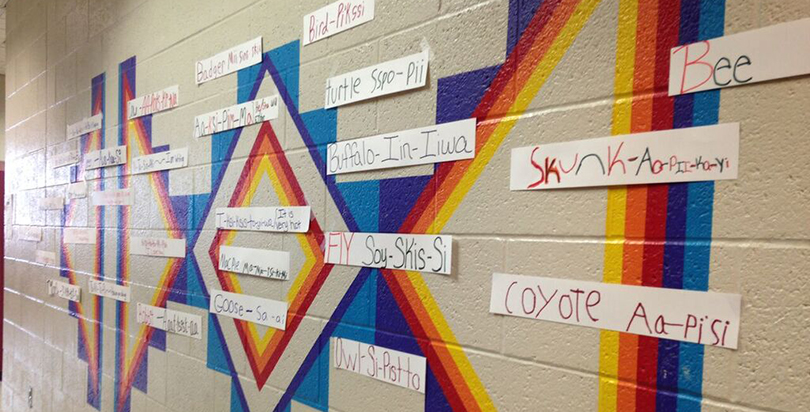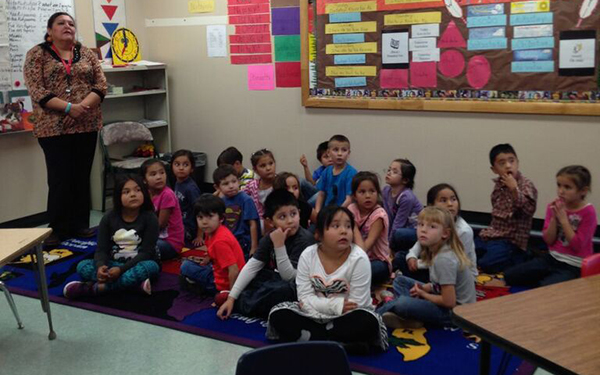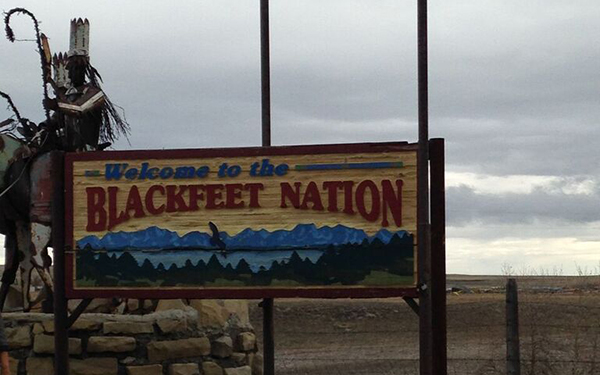Montana’s ‘Schools of Promise’: Inside the Fight to Turn Around America’s Remote Native American Classrooms

EDlection 2016 is The Seventy Four’s ongoing coverage of state-level education news, issues and leaders in the run up to 2016 elections. (Among our previous stories in this series, coverage from Iowa, Maryland,Missouri,N
Heart Butte, Montana
On the trip there, three-and-a-half hours from the capital of Helena, cell service and radio reception come and go. The road – speed limit 80 mph – winds for miles past vast plains, scattered farms and just one town big enough to have a gas station. Then, seemingly out of nowhere, a statue rises of two Native American warriors welcoming drivers to the Blackfeet Nation.
The same monument of the two riders — its base made of stones from a circa 1800s tribal mission and its figures crafted from the parts of rusted cars destroyed in a devastating 1964 flood — stands at each of the four main entrances to the 1.5 million-acre reservation.
From the southern gateway off Interstate 89, it’s another 19 miles to reach Heart Butte proper. The school sits on top of a hill overlooking the rest of town — a post office, an Indian Health Services outpost, a few dozen houses and three churches. And that’s pretty much it.
The nearest town, Browning, is 30 miles away, a do-able commute until the brutally snowy winters more or less cut off access. Many families make monthly journeys of more than 100 miles each way to stock up on groceries at the Wal-Mart in Great Falls, the closest large city.
It’s in that remote area that Greg Hirst, the superintendent-slash-French teacher, is attempting to educate 195 children from kindergarten through 12th grade, all of whom live on the Blackfeet reservation, at the Heart Butte School.
“My vision is simple: I just want a much better school,” Hirst said.
Creating that much better school — the key to breaking a cycle of poverty for Heart Butte’s children that has persisted for generations — will be no easy task. Money is tight, good teachers are hard to recruit, and the town’s isolation means many of the social safety net resources available elsewhere are missing here. Heart Butte is poised for potential turnaround — the school has routinely been identified as in need of improvement under federal performance guidelines — with a new program run by the state and funded by Washington, D.C.
The school, so small it’s fielding a six-man football team this year, has never got more than 52 percent of its students at or above the proficient level on state reading tests between 2007 and 2013, despite more than 80 percent of kids statewide hitting that benchmark those same years. Math and science results were worse.
“I think our community would be hard-pressed to give the reasons. They know our students as being alive and wanting to learn, and yet it doesn’t add up,” Hirst told a group of reporters and visitors from the state education office and Council of Chief School Officers touring the school in October.
With any program financed by Congress, the questions are will the resources be enough and how long will they last. Hirst believes in his bones that the kids of Heart Butte can do better and is hopeful this new program will provide the funding and expertise the school so sorely needs.
Students here haven’t had a strong structure in their early schooling, Hirst said, perhaps because the district didn’t have the proper programs and supports in place, or because of the school’s high staff turnover. Some 50 percent of the staff leave each year, voluntarily or involuntarily. The school board takes a “tough stance” in search of quality staff despite the difficulties in attracting teachers to such a remote location, Hirst said.
The students at Heart Butte School tend to come from homes without a lot of money. Jobs on the reservation are scarce, and many of their parents don’t work. Native Americans tend to have higher rates of illicit drug use, domestic and sexual violence and suicide than other races.
The school doesn’t really have a tax base — only about $15,000 of its $1.8 million annual budget comes from property taxes. Montana has a special state funding stream that aims to mitigate the impacts of that but revenue is still scarce. Heart Butte spends about $1,200 less per pupil every year than the roughly $10,400 per pupil state average. Officials rely in large part on a dizzying array of federal funds, including Impact Aid, with a sometimes-overwhelming amount of paperwork.
Nature — beautiful but dangerous in this part of the country, so far north that students live closer to the Canadian border than any major city in Montana — presents a threat.
In August, just as the school year was starting, a wildfire burned 70 acres of land near Heart Butte. No one was hurt and no homes were destroyed, but the whole town, population 582, had to evacuate.
The school’s roof needs $2 million in repairs, and other physical plant repairs have sometimes meant that curriculum is rarely updated or students lack the necessary books, Principal Carinna Hall said.
“Our students can handle it. We’re Blackfeet, and we’re tough people,” Hirst said. “Our community knows that we’re tough-minded, tough-willed people, but for some reason our public school has not been able to meet those needs.”
The Heart Butte school stands in stark contrast to the other school on the Blackfeet reservation, in Browning, the tribal headquarters. There, about 500 students fill a beautiful new high school. There’s a career and technical education program that’s adding new concentrations, and one of the three elementary schools provides dual language immersion for its kindergarteners in the Blackfeet language.

Hirst believes better incorporating the students’ tribal identity — the Blackfeet confederacy was a group of four tribes that hunted buffalo along what is now the Canadian-U.S. border; their name is thought to come from the black moccasins members wore — will help overcome some of these difficulties and be part of Heart Butte’s turnaround.
The school day now starts with the Blackfeet flag song, and Hirst helps students dig through family trees to find traditional Blackfeet names if they don’t already have them.
“Once we get our identity down, our students kind of, I believe, feel a head taller. I know the programs that have been tried, I know the efforts that have been brought in. But I really do not believe any of those will work until our students want to be here,” he said.
This is not just feel-good curriculum. There is considerable research evidence that solid ethnic studies, when taught well, have positive effects on academic achievement and social outcomes, particularly for students whose history has traditionally been marginalized, like Native Americans.

Five years ago, state Superintendent of Public Education Denise Juneau — herself an enrolled member of the Mandan and Hidatsa tribes who grew up in Browning— started Schools of Promise. The program, Montana’s effort to improve its lowest-performing schools, is funded by the federal School Improvement Grant, which provides similar grants to help states with struggling schools across the country.
Heart Butte is the eighth school in the sixth community, all on reservations, that will get School of Promise assistance. For Heart Butte, that means $1.4 million over three years.
Montana’s achievement gap is between its white students and American Indian children, who, at 11 percent of the school-age population, are the state’s largest minority group.
American Indian children who live on reservations face a type of poverty not unlike that found in urban areas, Juneau said. It’s deep, generational, isolated, and concentrated.
“When you have those four components of poverty, anywhere in the country, you’re going to have schools that are struggling with academic achievement, just because of a lot of the challenges of their context,” she said in an interview in her office in Helena ahead of the visit to Heart Butte.
Unlike children in Baltimore or the Bronx or other areas where families have been impoverished for decades, though, children on reservations don’t have access to the services or educational options available to children in big cities.
The remoteness of Heart Butte and the other reservation schools necessitated a new turnaround model. Rather than implement some of the more dramatic measures used elsewhere — converting to charters or dismissing and re-hiring large numbers of staff— Juneau “Montana-ized” the School Improvement Grant model using a more collaborative approach.
The state doesn’t have a charter law, and staffing schools in these remote areas is already an issue, Juneau said. She and her staff, with representatives of the state teachers union in tow, visited the schools that fit the formula for assistance to make the case that they should become a School of Promise.
“Because it was a significant amount of dollars, we knew it had to be more of a partnership than just a granting of dollars,” Juneau said. The state has doled out a little more than $11.5 million on the effort since 2010, and will have spent about $14 million in total when the grants run out.
Small groups from schools, including teachers and students, came up with plans for what was needed for turnaround, and then Juneau, plus school leaders and the president of the local union, signed on to an agreement.
The state held on to the money because officials say the districts, all very small, didn’t have the capacity to make large-scale changes. Instead, the state education office provided direct services to districts, things like instructional coaches and reading and math interventions. School board coaches help the lay people on the local board deal with the complexities of a multi-million dollar budget, hiring and firing, and the intricacies of federal funding.
Teachers also had to agree to a new evaluation system. Montana doesn’t have a federal Race to the Top grant or a No Child Left Behind waiver that in other states have been the impetus for an evaluation system tied to test scores.
Five years in, the program hasn’t always been successful. One district’s teachers union wouldn’t sign on; another district participated for one year but dropped out for the second.
Where schools have stuck with the program, though, Juneau says she sees results.
“I know when I walk into those schools now, they feel different. The community members talk differently about their school, where they feel it’s more welcoming. Students were leaving school, they’re now coming back. There’s just a sort of resurgence of belief in their public education system,” she said.
Hard numbers, though, are tougher to come by. Montana hasn’t had a statewide test in three years, so there isn’t test data to compare year by year. (The state was field testing the Smarter Balanced test, aligned to the more rigorous Common Core standards, in 2014 but this year’s exercise was so plagued with technical problems that Juneau let schools stop administering the exam.)
Graduation rates are disheartening. Of the three high schools that were served for four years, rates actually declined substantially at two — from 52.8 to 38.9 percent at Lame Deer High School between 2011 and 2014, and from 83.3 percent to 44.4 percent at Frazer High School. At Plenty Coups High School, the graduation rate was pretty much flat, at 63.1 percent in 2011 and 61.5 percent in 2014.
Juneau pointed out, though, that with class sizes as small as those at the Schools of Promise — the largest of the three high schools had a total enrollment of 95 — having only a few students drop out could cause a dramatically swing in a class’s graduation rate.
The state has funding to fully implement the program in Heart Butte in 2016-17, but after that is anyone’s guess. Republicans in D.C., now in charge of the federal purse strings, have been skeptical of setting aside funds designated just for school improvement. Juneau’s pitch to the legislature in Helena for state dollars went nowhere.
“We’ve been working with our congressional delegation” to get the federal dollars, she said. “We hope it does [come through] because it’s really good work. It’s some of the most important work we do as a state agency.”
Juneau hopes to soon be part of that delegation. Forced out of the state superintendent’s job next year by term limits, she announced in early November that she’ll challenge Republican Ryan Zinke for Montana’s lone seat in the House of Representatives.
The Heart Butte Model
Some money is already flowing to Heart Butte, but Montana got a year window to do some serious planning before implementing the full turnaround programming next August. But that doesn’t mean school staff are just waiting around in the meantime, Hall, the principal, said.
The teachers asked to make some changes now, she said. They’ve done diagnostic reading tests for their kindergarteners through sixth-graders and ordered appropriate materials; interventions will begin in the next few weeks. Faculty will take the interventions to the junior and senior high school students in January at the start of the new semester.
The school has also had some new professional development through a local college, as well as in-class instructional coaching. State and school officials are hunting for a school board coach and a counselor.
“I’m excited about Schools of Promise coming in” with the accompanying host of resources, both financial and professional, “but we are not waiting, we’re doing the work that needs to be done now,” Hall said.
The school is also bringing in other improvements at a smaller scale. A federal Twenty-First Century Learning grant finances many new after-school programs, everything from tutoring to ceramics to possibly a new robotics program or other STEM activity.
The grant also provides an evening school meal program: an afternoon snack, given at about 3:30, and dinner, offered between 5 and 6 p.m. The evening meal is free to anyone under the age of 18 — including the athletes on opposing sports teams that make the trek to a Heart Butte home game — and adults in the community can get a meal for $3.25. The school took the commitment a step further, sending a bus back down the hill to students’ houses to pick up those that didn’t stay after-school but might also be hungry.
“It was a big vision to put in for 100 students eating a night, and we actually are hitting that,” Hall said.
Hirst is also enriching the class offerings. After student council leaders approached him, he agreed to move the standard academic classes to earlier in the day and leave afternoon periods open for new electives. The deal is contingent, though, on the students performing well in their more core courses.
They now have class options like psychology, strength and conditioning, and basketball, all wildly popular with a group of students who spoke to the visitors. And while French is no longer offered at many public schools across the country because of declining enrollment and budget cuts, Hirst has brought the language of diplomacy to Heart Butte.
Most students hope to attend community college in nearby Browning, with the usual goal to transfer to the University of Montana’s main campus in Missoula, Hirst said.
Although all five high school students who spoke to the group of recent visitors have plans to leave the reservation after graduation — to Cornell University to study veterinary medicine, to University of California Santa Barbara to study law, to Gonzaga University for biology, to the U.S. Army, and to Missoula to become a pediatrician — they all want to return to the Blackfeet Nation.
“Montana is home,” said freshman Taysa Andrew. “We’ll come back and help our people. We know how it is on a reservation.”
Get stories like these delivered straight to your inbox. Sign up for The 74 Newsletter

;)
